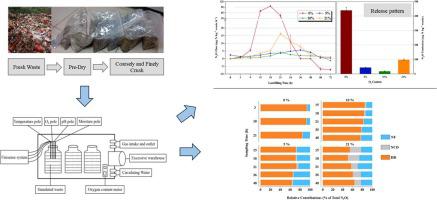Environment International ( IF 10.3 ) Pub Date : 2021-01-30 , DOI: 10.1016/j.envint.2021.106396 Chengliang Zhang , Xiaojun Wang , Lai Wei , Boguang Wang , Shaohua Chen

|
Nitrous oxide (N2O), an important greenhouse gas, is emitted from landfill reservoirs, especially in the working face, where nitrification and denitrification occur under different O2 concentrations. In order to explore the effects of O2 concentration on N2O emissions and production pathways, the production of N2O from simulated fresh waste landfilling under 0%, 5%, 10%, and 21% (vol/vol) O2 concentrations were examined, and 15N isotopes were used as tracers to determine the contributions of nitrification (NF), heterotrophic denitrification (HD), and nitrification-coupled denitrification (NCD) to N2O production over a 72-h incubation period. Equal amounts of total nitrogen consumption occurred for all studied O2 concentration and the simulated waste tended to release more N2O under 0% and 21% O2. Heterotrophic denitrification was the main source of N2O release at the studied oxygen concentrations, contributing 90.51%, 69.04%, 80.75%, and 57.51% of N2O under O2 concentrations of 0%, 5%, 10%, and 21%, respectively. Only denitrification was observed in the simulated fresh waste when the oxygen concentration of the bulk atmosphere was 0%. The nitrate reductase (nirS)-encoding denitrifiers in the simulated landfill were also studied and significant differences were observed in the richness and diversity of the denitrifying community at different taxonomic levels. It was determined that optimising the O2 content is a crucial factor in N2O production that may allow greenhouse gas emissions and N turnover during landfill aeration to be minimised.
中文翻译:

不同氧浓度下模拟垃圾填埋场N 2 O排放的时间分辨特征及产生途径
一氧化二氮(N 2 O)是一种重要的温室气体,它从垃圾填埋场中释放出来,尤其是在工作面中,在不同的O 2浓度下都会发生硝化和反硝化作用。为了探索的O的影响2上N浓度2个O排放和生产途径中,制备N 2下0%从模拟新鲜垃圾填埋O,5%,10%,和21%(体积/体积)O 2检查浓度,并使用15 N同位素作为示踪剂以确定硝化(NF),异养反硝化(HD)和硝化耦合反硝化(NCD)对N 2的贡献在72小时的孵育时间内产生O。总氮消耗等量的发生对所有研究的Ò 2浓度和模拟废物倾向于释放更多Ñ 2下0%和21%○○ 2。异养脱氮为:N的主要来源2在所研究的氧浓度ø释放,贡献90.51%,69.04%,80.75%,以及N 57.51%2下○○ 2 0%,5%,10%,21的浓度%, 分别。当整体气氛中的氧气浓度为0%时,在模拟的新鲜废物中仅观察到反硝化作用。硝酸还原酶(NIRS还研究了模拟垃圾填埋场中的(-)编码反硝化剂,并观察到了不同分类学级别的反硝化群落的丰富性和多样性差异。已确定优化O 2含量是N 2 O生产中的关键因素,可以使填埋曝气期间的温室气体排放量和N转换量降至最低。











































 京公网安备 11010802027423号
京公网安备 11010802027423号